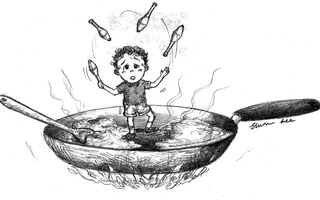“Tonight, you hold this show in your hands…or rather, your feet.” This is an unusual message, but one that draws attention to the peculiar nature of “Sequence 8,” a performance by the French-Canadian circus company “7 Doigts de la Main” that runs at the Cutler Majestic Theatre at Emmerson College through October 7. There is no formal plot; it is much more about acrobatic flips than narrative turns. The production takes clowning’s precedent of gaudy pastiche and smashes it into pieces, bringing forth a show that connects an otherwise surreal performance to everyday human experience.
The show starts with an acrobatic dance from all eight of the performers, who energetically jump at the audience, highlighting the performances slanted and moving lines. Next comes the russian bar—a type of flexible balance beam—which is used to launch one of the female acrobats 20 or 30 feet into the air. This is followed by a routine by world-renowned cigar box juggler Eric Bates, who took three otherwise mundane objects and whirled them around the stage in a truly stupefying display of talent.
It is the music that helped draw the emotional content out of the performance. Seth Stachowski and Nans Bortuzzo—responsible for original music and remixing, respectively—deftly marry the visuals to the sound that accompanied and amplified it. The music in the show ranges from contemporary compositions that fill the theater with sweeping and powerful tones, to the vivacious or gloomy tones of artists like “The Mountain Goats” or “C2C.” The importance of the music becomes clear in a beautiful section in the second half of the show featuring Alexandra Royer, one of the two female acrobats, performing her specialty aerial hoop routine. Royer’s talent is unmistakable, but the music is what fleshed out the power of the movement in the show: Her display is given a sense of nuance by her interaction with the music and bridges the gap between circus and dance.
Given the acrobatic nature of the performance, the set was relatively sparse: just a collection boxes, a desk, a lamp, and a bunch of hanging frames. However, the lighting design of the show, done by Nol Van Genuchten, was very complex and was integral in transforming these performers in to emotional characters. For example, the bright lights in the Bate’s cigar-box toss, juxtaposed against the deep purple of Royer’s hoop scene, helped to create a sense of individual character and emotional evolution.
The acts were brief, so the show was filled with small skits in between each act. These were mostly comic interludes usually contrasted with the acrobatic routine that preceded them and were consequently a bit disorienting. The goal was most likely to brighten the mood after darker moments, but it seemed forced and broke the overall flow of the piece. The show could perhaps be strengthened by a larger narrative structure that integrated these little skits into the larger picture and made them vehicles for a smooth transition between acrobatic acts.
However, this small drawback of the production pales in comparison to the resounding success it has in the one thing that matters most: creating an emotionally resonant piece of art. “7 Doigts de la Main” has done a remarkable job of creating a circus with a twist: one that dazzles with both its technical expertise and its ability to access broader human emotion.
Read more in Arts
Even When No One is LookingRecommended Articles
-
 When the (Jerkus) Circus Comes to Town...
When the (Jerkus) Circus Comes to Town... -
 The Circus Is In Town!
The Circus Is In Town! -
 Circus Skills Help Mayora on the Field
Circus Skills Help Mayora on the Field -
 Veteranyi Cooks Up a Storm in Impressionistic ‘Polenta’
Veteranyi Cooks Up a Storm in Impressionistic ‘Polenta’ -
The EtherealsThe Ethereals, who comprise acrobatic Nicolas Maffey ’13 and a live band, will perform at Arts First.
-
'Pericles, Prince of Tyre' Brings the Circus to TownWhile it may come as a surprise, Shakespeare only wrote of part of “Pericles, Prince of Tyre.” The other half is most likely penned by another writer, George Wilkins. In the Harvard-Radcliffe Dramatic Club’s latest incarnation of this romance, “Pericles” will add even more collaborators as a cast and crew of Harvard students bring their own ideas to the table.













